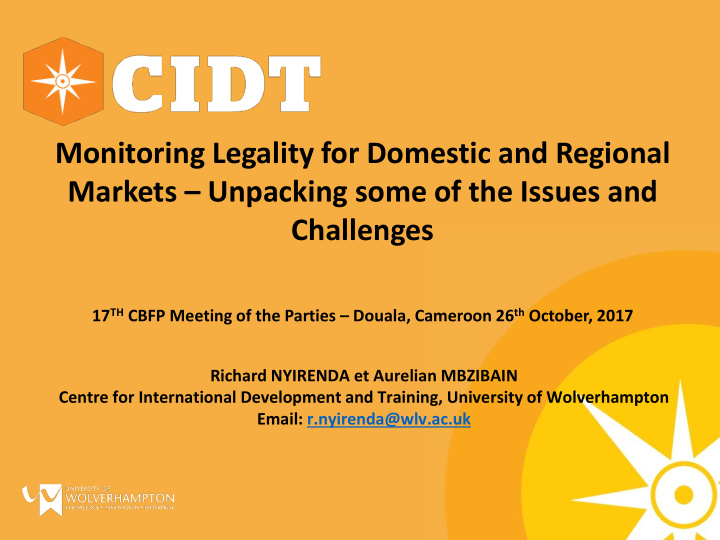



Monitoring Legality for Domestic and Regional Markets – Unpacking some of the Issues and Challenges 17 TH CBFP Meeting of the Parties – Douala, Cameroon 26 th October, 2017 Richard NYIRENDA et Aurelian MBZIBAIN Centre for International Development and Training, University of Wolverhampton Email: r.nyirenda@wlv.ac.uk
Outline 2 2. The Nature of Domestic 1. Illegality in the and Regional Markets Forest Sector 4. Issues & 3. Understanding Challenges for the Drivers Monitoring 5. Some Options
Illegality in the Forest Sector 1. Two main types of ‘illegal logging’ (Sam Lawson, Earthsight): “ illegal illegal ” vs “ legal illegal ” 1. ‘Legal illegal’ is more prevalent than ‘illegal illegal’ but gets less attention 2. ‘Legal illegal’ is wrongly assumed to be less serious or have less impact, but in some ways it is worse 3. ‘illegal illegal’ – mostly on the domestic and regional markets
The Nature of Domestic & Regional markets Two main characteristics; 1. Small and medium sized forest enterprises (SMFEs) 2. Informal and Artisanal actors or operators
Small Medium Forest Enterprises • Range from 1 person operations or companies to firms that can have as many as 100 employees • Often flexible with rapid decision making processes & larger share of profits normally re-invested in the local economy • More labour than capital intensive – effective means of generating employment • Can have low environmental impact – tend not to use heavy machinery
Small Medium Forest Enterprises • Limited access to finance or technical support old equipment, inefficient and unsafe • Limited capacity to keep up to date with changes in policy, legal framework, markets, higher value-added production • High levels of informality – small to no contributions to tax revenues • Regarded by government as backward and not compatible with development and export oriented investment strategies
Informal and Artisanal • Informal rural economy – broadly defined as economic activity not subject to government regulation or taxation (‘illegal – illegal’) ( Schneider, 2002 ) • ‘ Contemporary governance ’ dilemma in international development ( Benson et al, 2014 ) • Supports some of the most vulnerable in society – in sub- Saharan Africa it generates 90% of employment opportunities and contributes to up to 38% of GDP in some countries ( Vorley et al, 2014 ) • In rural economies sustains livelihoods of impoverished groups through natural resource & land based activities e.g. farming, logging & mining
Informal and Artisanal • Not new to rural economies – developed informal rules to manage resources but traditional informality now increasingly coalescing with regional and global markets • Messy and complex – illegal but often rooted in traditional resource and land rights • Connection between informality and vulnerable groups resulting in lack legal and social protection ( Chen, 2012 ) • Sustainability of resource is a concern particularly now it is serving expanding urban and international markets
Understanding the Drivers of Informality 1. Weng, 2015 proposes 3 areas of inquiry and 3 spatial scales 2. Spatial scales • Macro level - Political economy • Meso level - Value chain • Micro level – rural/urban actors 3. Key Areas of Inquiry • Rights • Regulation • Economics
Macro Level – Meso Level – Micro Level – Political Economy Value Chain Rural/Urban Actors • • Forest tenure conflicts Informal activities Rights between state & rural as resistance communities again unjust tenure • State forest ownership arrangements • • • Regulation Elite capture of forest Separation Cost of compliance resource governance between informal too high • Policies such as & formal timber revenue sharing, CF sectors except for etc not delivering certain high value benefits timber species • • • Economics Huge economic Demand from One of the few benefits to wide of growing low- employment stakeholders (FD income opportunities • officials, police, consumers in Critical livelihood customs, farmers etc) urban areas option • Significant income compared to agriculture
Issues & Challenges for Monitoring Legality 1. Legality is only one aspect of the larger question of survival and competitiveness with which SMFEs & informal operators deal with on a daily basis 2. Heterogeneity of SMFEs and the informal sector – different barriers for different actors 3. Barriers to achieving and maintaining legality – informal in nature and when formality is achieved they struggle to maintain it 4. Barriers to demonstrating legality – demonstrating legal compliance more of a challenge than simply being legal; e.g. complexities and costs of developing traceability systems, obtaining independent verification or certification etc
Issues & Challenges for Monitoring Legality 5. Barriers to competitiveness - Lack of financial or technical capacity impedes achievement of legal requirements such as management plans etc 6. The usual issues; • weak law enforcement, inappropriate policy and institutional frameworks • Insufficient financial and technical support
So what!! 1. Policy and regulatory options that address the drivers of informality • Understanding the underlying drivers of informality • forest sector reaching out to other sectors - mapping all institutions beyond traditional forest sector actors that are involved in trade all the way to the point of export 2. Understanding the heterogeneity of the actors in the domestic and regional markets Respectful • including actors in other positions along the supply chain • Identify the invisibilities - policies designed to work for one type of business or supply chain may be ill-suited to another 3. Identify the difference between informality and legality • Resolved the disconnect between legal regimes and rural/urban realities
www.cidt.org.uk/cv4c twitter.com/eucv4c
Recommend
More recommend